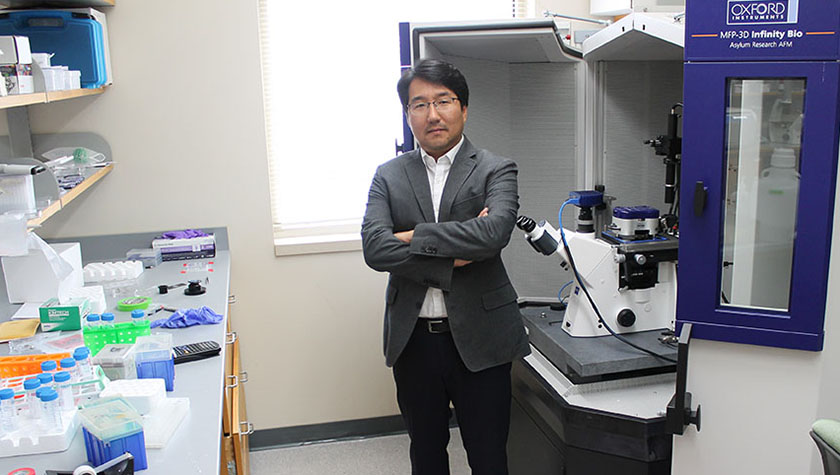
With funding from the Discovery to Product program, Professor Seungpyo Hong and his collaborators are accelerating their research on idiopathic pulmonary fibrosis
By Nicole Etter
Patients with idiopathic pulmonary fibrosis and COVID-19 survivors with damaged lungs could eventually breathe easier because of a new treatment in development at the University of Wisconsin–Madison. School of Pharmacy Professor Seungpyo Hong, Milton J. Henrichs Chair in Pharmaceutical Sciences and director of the Wisconsin Center for NanoBioSystems (WisCNano), along with Allan Brasier, executive director of the UW Institute for Clinical and Translational Research, and QuadraGenics, a biotechnology company co-founded by Brasier, recently received a State Economic Engagement and Development (SEED) grant from UW’s Discovery to Product (D2P) program to get their innovative research closer to the marketplace.
The outlook for idiopathic pulmonary fibrosis has been bleak: Patients’ lungs become inflamed and then increasingly clogged with scar tissue that blocks the flow of oxygen. With no existing cure, most patients die of respiratory failure three to five years after diagnosis. This devastating disease affects up to 3 million people worldwide and kills 40,000 Americans every year, and a growing number of survivors of severe COVID-19 have also developed fibrosis in the lungs, with a long-term outlook that’s still unclear.
But nanomedicine approaches offer new hope. Through the SEED grant, funded by the Wisconsin Economic Development Corp., the UW–Madison research team is working on novel molecular drug delivery technologies to more effectively treat pulmonary fibrosis.
“Millions of people are suffering from this disease, and if we can prove that our treatment is safer and more efficacious, it’s going to be really helpful for that large population,” Hong says.
“Millions of people are suffering from this disease, and if we can prove that our treatment is safer and more efficacious, it’s going to be really helpful for that large population.”
—Seungpyo Hong
The team’s strategy: to create an inhalable treatment that uses aerosolized “smart” nanoparticles that can stop the progression of fibrosis and reverse the damage already done to the lungs. The treatment works by inhibiting bromodomain containing protein 4 (BRD4), which is key to the growth of fibrosis. The nanoparticles are designed to selectively bind to fibronectin, a protein that makes the damaged tissues stiff, ensuring that the treatment goes where it’s most needed. The BRD4 inhibitors are encapsulated in the same nanoparticles to prolong the drug’s effect.
It has the potential to be a huge improvement over the two existing U.S. Food and Drug Administration-approved treatments for idiopathic pulmonary fibrosis, which use different drug molecules, are typically delivered by IV, and can slow — but not stop or reverse — the disease.

“One of the biggest issues was how to deliver this in a stable way so the drug can go to the target region and be more effective in treating fibrosis,” Hong explains. “Ultimately, we are trying to develop an inhalable system so we can deposit drugs deep into the lung, where fibrosis happens. By using nanoparticles, which are still really small, and then by increasing their size, we can actually design them to deposit better to the lungs. One of the advantages of using nanotechnology is we can really boost the binding kinetics by up to five orders of magnitude, which should translate to better efficiency and efficacy.”
The more targeted approach could also reduce side effects.
“No drug is nontoxic,” Hong notes. “One of the ways to improve the safety of medicines is to reduce the dose. Using this nanoparticle delivery system could allow us to reduce the dose while getting the same effect.”
The research could have applications beyond pulmonary fibrosis. BRD4 plays a pivotal role in driving mucosal inflammation, which is also a factor in asthma and inflammatory bowel disease, and the drug delivery mechanism could be a platform technology for a wide variety of diseases.
“Depending on how we engineer the surface, we can make this nanoparticle delivery mechanism selective to different markers,” Hong says. “It has a lot of opportunity.”
Preliminary results in the lab have been promising, showing that the treatment reverses collagen deposits in a lung fibrosis model. The D2P funding will allow the research team to expand pre-clinical testing and accumulate the additional data needed to pave the way for clinical trials in four to five years. To ultimately bring the new treatment to market, Hong and Brasier may continue to partner with QuadraGenics, connect with another biotech startup or create a new startup company.
“Hopefully this initial funding from D2P will boost our collaborations with local companies and the economy of Wisconsin,” Hong says.